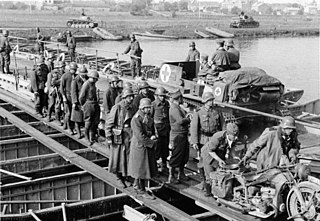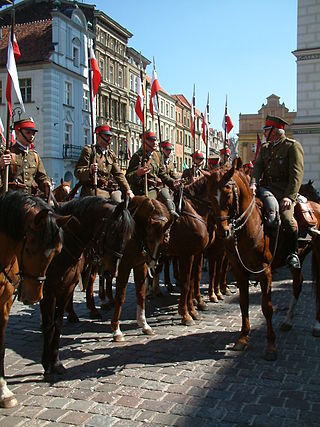
The Battle of Kock was the final battle in the invasion of Poland at the beginning of World War II in Europe. It took place between 2–5 October 1939, near the town of Kock, in Poland.

The Siege of Warsaw in 1939 was fought between the Polish Warsaw Army garrisoned and entrenched in Warsaw and the invading German Army.
The Fallschirm-Panzer-Division 1. Hermann Göring was a German Luftwaffe armoured division. The HG saw action in France, North Africa, Sicily, Italy and on the Eastern Front during World War II. The division began as a battalion-sized police unit in 1933. Over time it grew into a regiment, brigade, division, and finally was combined with the Parachute-Panzergrenadier Division 2 Hermann Göring on 1 May 1944 to form a Panzer corps under the name Reichsmarschall. It surrendered to the Soviet Army near Dresden on 8 May 1945.

The Battle of Mokra took place on 1 September 1939 near the village of Mokra, 5 km north of Kłobuck and 23 km north-west of Częstochowa, Poland. It was one of the first battles of the Invasion of Poland, during the Second World War, and was one of the few Polish victories of that campaign and the first German defeat of the conflict.

Polish 1st Legions Infantry Division is a tactical unit of the Polish Army. Formed on February 20, 1919, partially of veterans of the I Brigade of the Polish Legions, the unit saw extensive action during the Polish-Soviet War and World War II. Regarded by the soldiers of the Wehrmacht as the Iron Division, it distinguished itself in the Invasion of Poland.

The 7th Infantry Division was the name of several units of the Polish Army.
The 8th Infantry Division was a tactical unit of the Polish Army. It was active in the Polish-Bolshevik War, as well as during the Invasion of Poland in 1939. During World War II, the division was reformed twice as part of two distinct armed forces: once as part of the Home Army during the Warsaw Uprising and again as part of the Polish Army in the East.
The Malaya Command was a formation of the British Army formed in the 1920s for the coordination of the defences of British Malaya, which comprised the Straits Settlements, the Federated Malay States and the Unfederated Malay States. It consisted mainly of small garrison forces in Kuala Lumpur, Penang, Taiping, Seremban and Singapore.

The Air Force of the Polish Army, unofficially known as the People's Polish Air Force was the name of the Soviet-controlled Polish Air Force in the USSR between 1943 and 1947 created alongside the Polish People's Army, a subordinate to the Red Army. It was the primary Polish air force formation within the Polish Armed Forces in the East during World War II.
The Battle of Hannut was a Second World War battle fought during the Battle of Belgium which took place between 12 and 14 May 1940 at Hannut in Belgium. It was the largest tank battle in the campaign. It was also the largest clash of tanks in armoured warfare history at the time.

Pomeranian Cavalry Brigade was a cavalry unit of the Polish Army in the interbellum period. It was created on April 1, 1937 out of the Cavalry Brigade "Bydgoszcz". Its headquarters were stationed in Bydgoszcz and the brigade consisted of these units:

The Battle of Sedan or Second Battle of Sedan took place in World War II during the Battle of France in 1940. It was part of the German Wehrmacht's operational plan codenamed Fall Gelb for an offensive through the hilly and forested Ardennes, to encircle the Allied armies in Belgium and north-eastern France. German Army Group A crossed the Meuse with the intention of capturing Sedan and pushing westwards towards the Channel coast, to trap the Allied forces that were advancing east into Belgium, as part of the Allied Dyle Plan.

Suwalska Cavalry Brigade was a cavalry unit of the Polish Armed Forces of the Second Polish Republic in the interbellum period. It was created on April 1, 1937, out of the 4th Independent Cavalry Brigade. Its headquarters were stationed in Suwałki and the brigade consisted of these units:

15th Poznań Uhlan Regiment – unit of Polish cavalry, part of Greater Polands Army, Polish Army of Second Republic and Polish Armed Forces in the West during World War II.

Battle of Łomża was a series of armed engagements during the Nazi German and Soviet Invasion of Poland. The battle took place in and around the town of Łomża, on both sides of the Narew River. Polish forces successfully held a series of pre-First World War forts from repeated German attack before being forced to withdraw due to the position becoming untenable following their losses at the Battle of Wizna and Battle of Nowogród.

16th Greater Poland Uhlan Regiment of General Gustaw Orlicz-Dreszer was a cavalry unit of the Polish Army in the Second Polish Republic. In the interbellum period, it was garrisoned in the city of Bydgoszcz.
The full structure of the Polish Land Forces is:
The Battle of Barak was fought on September 7–8 between Polish and German forces during the 1939 German Invasion of Poland

Julian Edwin Arnoldt-Russocki was a Polish lieutenant colonel of the Polish Armed Forces who commanded the 16th Greater Poland Uhlan Regiment during the early battles of the Invasion of Poland and was the main commander at the Battle of Bukowiec before being captured two days later.

42th Infantry Regiment was an infantry regiment of the Polish Armed Forces of the Second Polish Republic. They stationed at the barracks Traugutta street in Białystok.













